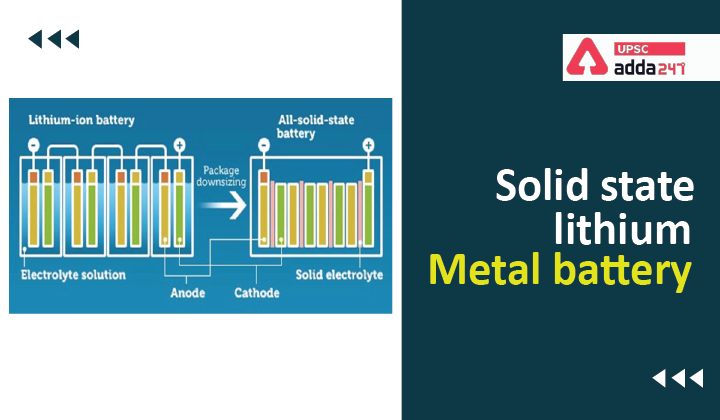Table of Contents
Solid State Lithium Metal Battery: Relevance
- GS 3: Science and Technology- developments and their applications and effects in everyday life.
Solid State Lithium Metal Battery: Context
- Recently, Shareholders of California-based QuantumScape Corp, a battery startup backed by Volkswagen AG, have approved a multibillion-dollar pay package. It has triggered comparisons with the package that Tesla awarded Elon Musk in 2018.
Solid State Lithium Metal Battery: Key points
- QuantumScape’s solid-state battery is seen as an exceptionally bright prospect in an increasingly crowded space.
- Solid-state batteries or SSBs are the lithium-ion batteries made with solid electrolytes.
- Solid-state batteries are an emerging option for next-generation traction batteries promising low cost, high performance and high safety.
Benefit of Solid State Lithium Metal Battery
- The nascent technology has the potential to trump the current incumbent—lithium-ion batteries made with liquid electrolytes—by being stable at high temperatures, which enables safer operation and better performance.
- SSBs promised that electric vehicles and mobile phones will no longer be at risk from batteries that catch fire.
- The solid electrolyte perse doesn’t improve performance, but its stability and barrier properties allow the safe use of energy-dense anode materials such as lithium metal and silicon that help the SSBs outperform the lithium-ion batteries that are in use today.
- A solid-state battery has higher energy density than a Li-ion battery that uses liquid electrolyte solution. It doesn’t have a risk of explosion or fire, so there is no need to have components for safety, thus saving more space.
- A solid-state battery can increase energy density per unit area since only a small number of batteries are needed. For that reason, a solid-state battery is perfect to make an EV battery system of module and pack, which needs high capacity.
How solid-state lithium battery is different from liquid lithium battery?
- A traditional lithium-ion battery has an anode, a separator immersed in a liquid electrolyte, and a cathode. During discharge, lithium ions flow from the anode to the cathode through the electrolyte and across the separator.
- SSB, on the other hand, do not need a separator, since the solid electrolyte acts as a physical barrier between the anode and cathode.
Challenges associated with Solid State Lithium Metal Battery
- There are various scientific challenges associated with using solid electrolytes.
- Its developers are yet to prove that they can make SSBs at commercial scale.
Also Read:





 TSPSC Group 1 Question Paper 2024, Downl...
TSPSC Group 1 Question Paper 2024, Downl...
 TSPSC Group 1 Answer key 2024 Out, Downl...
TSPSC Group 1 Answer key 2024 Out, Downl...
 UPSC Prelims 2024 Question Paper, Downlo...
UPSC Prelims 2024 Question Paper, Downlo...





